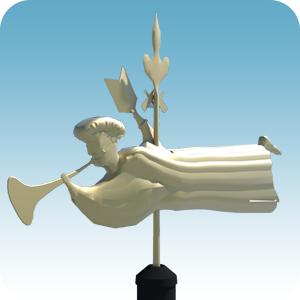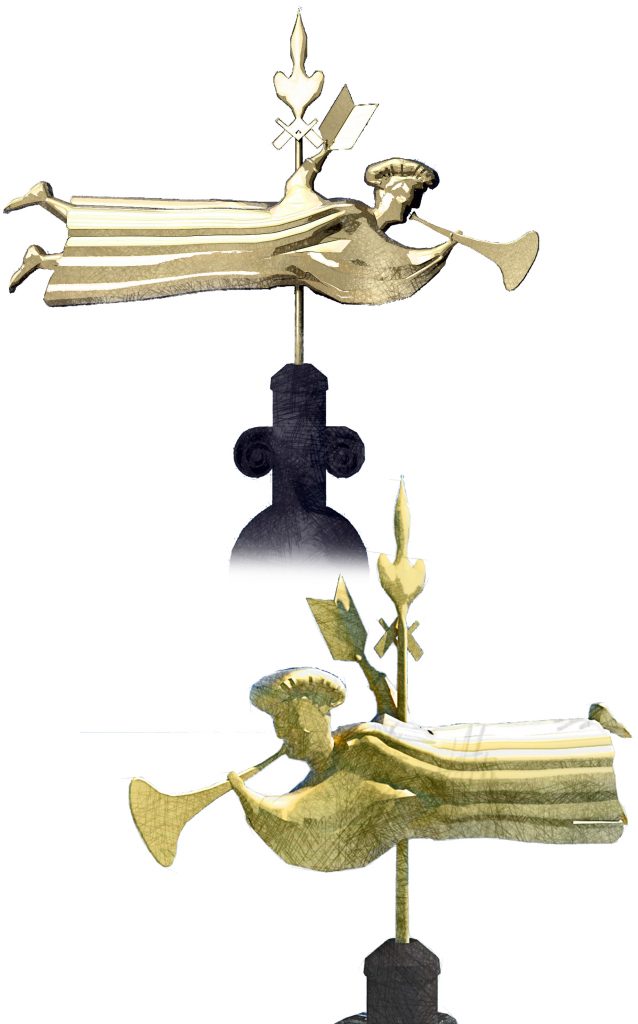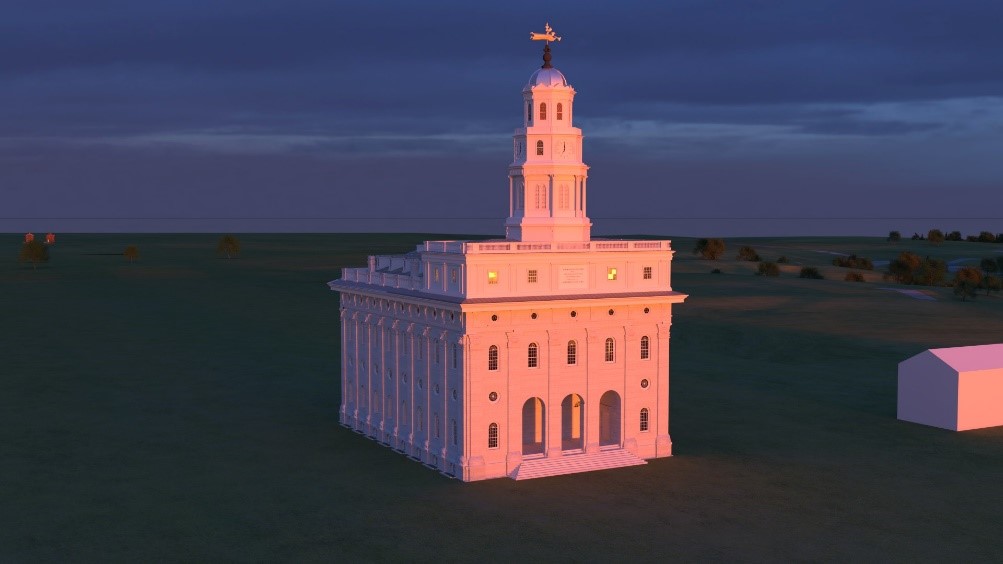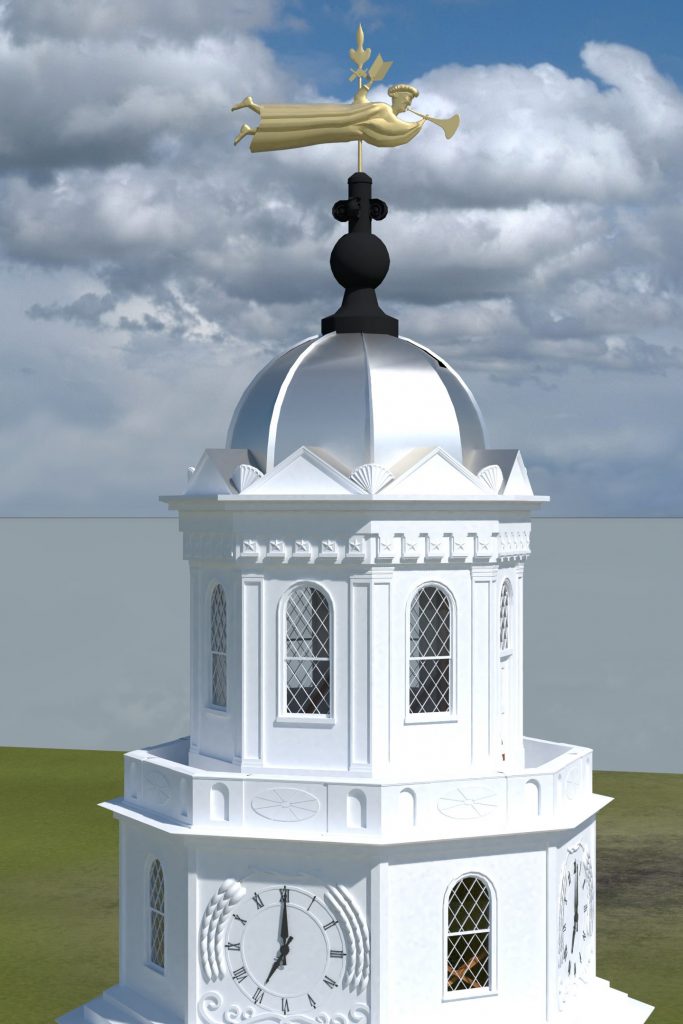
| SCULPTOR | Nauvoo Tinner’s Association |
| MATERIAL | Hammered Tin |
| PLACED | 30 January 1846 |
| LENGTH | 5 feet (1.5 Meters) |
| CURRENTLY ON | 0 Temple(s) |
Flying in the Midst of Heaven
The First Angel, placed on the Original Nauvoo Temple, was actually a 5 foot long weather vane.[1]Lisle Brown, “Exterior of the Description of the Nauvoo Temple” marshall.edu, March 1999 Sculpted in tin and formed as a 3 dimensional figure, it was fashioned in the likeness of a man. The completed weather vane was then covered in gold.[2]Perrigrine Sessions reminiscences and diaries, 1839-1886; Journal typescript, 1845-1886; Church History Library, (accessed: August 12, 2019) The figure was laying horizontal, as if flying. Rather than being specifically named as Moroni, this flying angel was a representation of the angel described in the verse in Revelation 14:6. While the Angel had not been identified with the name Moroni, by the time the Angel was placed, a revelation linking Moroni with the angel of the book of revelation had already been given and known to the Church in 1831, just over 12 years earlier. While no one explicitly calls the weathervane Moroni, the connection may have already been made by some at that point.

Early drawings of the Nauvoo Temple by the Temple’s architect, William Weeks don’t show the weathervane, but they also showed a temple without an attic story, and a much different spire.
Sometime after the temple was designed, William would draw a detailed design for a flying angel with a trumpet. It is not known if this idea was original to Weeks, or a request from President Smith.
Placement
The ball under the weather vane, as well as the rod the angel would pivot around were placed on 10 September 1845. [3]Roe, Frederick Robert 1920-. Angels: Moroni and his associates / Fred Roe [Bountiful, Utah]: The Author, 1992 May 1992 printing, (accessed: August 12, 2019)The Angel itself was placed on 30 January 1846 at 9 AM, just 4 months before the temple was dedicated.[4]Historical Department journal history of the Church, 1896-2001 July; 1840-1849; 1846 January-July; Church History Library, (accessed: August 12, 2019)[5]Womens Exponent XII, No. 11, (1 November 1883), p. 81.
There are many accounts attesting to either the inclusion of the weather vane on the spire, or its actual placement.
A reporter for the Cincinnati Times related the account of a visitor to the temple in 1846, in which they described the glittering Angel with trumpet in hand.[6]Deseret News, 7 March 1876, citing an article from Cincinnati News, no date
Thomas L. Kane visited Nauvoo shortly after the exodus of the Saints. He praised their fortitude in remaining long enough to finish the temple, including, as he said, “even gilding the angel and trumpet on the summit of its lofty spire.”[7]Thomas L. Kane, The Mormons, A discourse (Philadelphia, Pa.), The Historical Society of Pennsylvania, King Bairs Printers, 1850.
The son of the Prophet, Joseph Smith III noted the weathervane in his writing. He wrote of watching the construction of the temple from its beginnings to “the gilded angel with his brave trumpet in his hand, that swung on the top the spire.”[8]Mary Andentia Smith Andersen, ed., Joseph Smith and the Restoration, (Independence, Mo: Herald House, 1952), pp. 100-101.
One Pioneer, Perregrine Sessions wrote of the placement of the spire in his journal:
“On this day they raised the feign [sic] which is the representation of the angel in his priestly robes with a Book of Mormon in one hand and a trumpet in the other which is overlaid with gold leaf.”[9]Perrigrine Sessions reminiscences and diaries, 1839-1886; Journal typescript, 1845-1886; Church History Library, (accessed: August 12, 2019)
While Angel weather vanes were nothing new, being found on buildings all over the world, this new weather vane would bear features distinct to the Latter-day Saint beliefs.
Description
The angel held a book aloft in one hand above his person. In the other hand he held a horn to his mouth, representing the gospel being declared “as with the voice of a trumpet,” as stated in Doctrine and Covenants 24:12.
The figure was dressed in priestly robes and a rounded bonnet, with bare feet. The attire is not unlike that worn by the Temple priests in ancient Jerusalem.
Above the Angel was the symbol of the square and compass, along with a stylized flame of fire.[10]Lisle Brown, “Nauvoo Temple Exterior Symbolism,” marshall.edu, March 1999 There are many theories as to why the Compass and square are included on the statue, though no official account exists. Some of these theories focus around the compass representing the heavens, and the square representing the four corners of the earth, the two together representing the preaching of the gospel to the whole earth.
The flame above the compass and the square possibly represents the Holy Ghost, based on representations like the one in Acts2:3-4
And there appeared unto them cloven tongues like as of fire, and it sat upon each of them.
And they were all filled with the Holy Ghost, and began to speak with other tongues, as the Spirit gave them utterance.
Fate of the Weather vane
Speculation has been made by many as to the eventual fate of the weather vane. Many theories abound, including one, talked about in a later chapter that the angel ended up in Cincinnati. Theories have included that it was sold, along with the furniture and paintings from the temple, to pay for the trek west.
It has also been suggested that the vane was damaged by a lightning strike in September of 1846.
Removed
Most theories focus upon reports that the Angel was removed from the temple late September through early October of 1846. Thomas Bullock was driven from Nauvoo on September 20th. In his journal he recorded a conversation with Benjamin Baker, who reported the news that the Angel had been removed by the mob the previous Friday.[11]Illinois Journal, 9 December 1853, as republished in the Journal of the Illinois State Historical Society 38 (1945): 484. This places the removal either September 25th or October 2nd.
Another visitor to the temple sometime in the fall of 1846 reports the Angel as having been stored inside the tower. [12]J. M. Davidson, editor of the Carthage Republican, 25 February 1864, as cited in E. Cecil McGavin, The Nauvoo Temple (Salt Lake City: Deseret Book, 1962), 93–95; also,“The Old Temple,” Nauvoo Independent 7,no. 9 (20 December 1889): 7.
As mentioned previously, Thomas L. Kane visited the temple in early October, and in his report the Angel is on the steeple.
This proposes 2 possible scenarios.
- The first, is that Kane visited the temple on October first, and the Angel was removed on October second .
- The second scenario is that Thomas Kane visited in later October. This would require that the Angel was removed on either 25 September or the second of October, and had been placed back on the temple by the time of Thomas Kane’s visit.
Returned
That the Angel was returned is a matter of record. Thomas Bullock reports seeing the Angel on October 8, and that it was “all safe.” While it is possible that Bullock saw the angel safe in the tower, An Illinois Journal of 9 December 1853 recounted one individual’s summer visit to the temple some years before. The narrator describes the damage done by the mob and subsequent visitors to the temple, placing the visit either in the summer of 1847 or the summer of 1848.[13]Don F. Colvin, “Nauvoo Temple : A Story of Faith > 11. The Fate of the Temple,” rsc.byu.edu, 2002. Among all the details described by the writer is that “a tin, gilded angel atop the tower, “holding in one hand a trumpet, and in the other a book.” [14]Illinois Journal, 9 December 1853, as republished in the Journal of the Illinois State Historical Society 38
(1945): 484.
Destroyed?
The theory most supported as to the eventual fate of the Angel is that the fire of 1848 that destroyed the tower, and all of the temple except for the stone walls, was also responsible for the destruction of the weather vane.

Chapter 2 Navigation
Related Articles
Myth 7 I Moroni Once Had Wings →
Myth 8 I Nauvoo Angel on the Assembly Hall →
References
| ↑1 | Lisle Brown, “Exterior of the Description of the Nauvoo Temple” marshall.edu, March 1999 |
|---|---|
| ↑2, ↑9 | Perrigrine Sessions reminiscences and diaries, 1839-1886; Journal typescript, 1845-1886; Church History Library, (accessed: August 12, 2019) |
| ↑3 | Roe, Frederick Robert 1920-. Angels: Moroni and his associates / Fred Roe [Bountiful, Utah]: The Author, 1992 May 1992 printing, (accessed: August 12, 2019) |
| ↑4 | Historical Department journal history of the Church, 1896-2001 July; 1840-1849; 1846 January-July; Church History Library, (accessed: August 12, 2019) |
| ↑5 | Womens Exponent XII, No. 11, (1 November 1883), p. 81. |
| ↑6 | Deseret News, 7 March 1876, citing an article from Cincinnati News, no date |
| ↑7 | Thomas L. Kane, The Mormons, A discourse (Philadelphia, Pa.), The Historical Society of Pennsylvania, King Bairs Printers, 1850. |
| ↑8 | Mary Andentia Smith Andersen, ed., Joseph Smith and the Restoration, (Independence, Mo: Herald House, 1952), pp. 100-101. |
| ↑10 | Lisle Brown, “Nauvoo Temple Exterior Symbolism,” marshall.edu, March 1999 |
| ↑11 | Illinois Journal, 9 December 1853, as republished in the Journal of the Illinois State Historical Society 38 (1945): 484. |
| ↑12 | J. M. Davidson, editor of the Carthage Republican, 25 February 1864, as cited in E. Cecil McGavin, The Nauvoo Temple (Salt Lake City: Deseret Book, 1962), 93–95; also,“The Old Temple,” Nauvoo Independent 7,no. 9 (20 December 1889): 7. |
| ↑13 | Don F. Colvin, “Nauvoo Temple : A Story of Faith > 11. The Fate of the Temple,” rsc.byu.edu, 2002. |
| ↑14 | Illinois Journal, 9 December 1853, as republished in the Journal of the Illinois State Historical Society 38 (1945): 484. |

